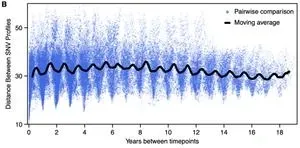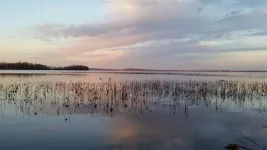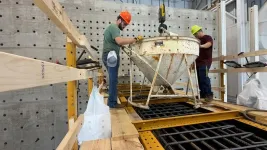(Press-News.org) CORVALLIS, Ore. – Scientists including an Oregon State University chemistry researcher have taken a key step toward faster, more energy-efficient artificial intelligence, and data processing in general, with the discovery of luminescent nanocrystals that can be quickly toggled from light to dark and back again.
“The extraordinary switching and memory capabilities of these nanocrystals may one day become integral to optical computing – a way to rapidly process and store information using light particles, which travel faster than anything in the universe,” said Artiom Skripka, assistant professor in the OSU College of Science.
Published in Nature Photonics, the study by Skripka and collaborators at Lawrence Berkeley National Laboratory, Columbia University and the Autonomous University of Madrid involves a type of material known as avalanching nanoparticles.
Nanomaterials are tiny bits of matter measuring between one-billionth and one-hundred-billionths of a meter, and avalanching nanoparticles feature extreme non-linearity in their light-emission properties – they emit light whose intensity can increase massively with a small increase in the intensity of the laser that’s exciting them.
The researchers studied nanocrystals composed of potassium, chlorine and lead and doped with neodymium. By themselves, the KPb2Cl5 nanocrystals do not interact with light; however, as hosts, they enable their neodymium guest ions to handle light signals more efficiently, making them useful for optoelectronics, laser technology and other optical applications.
“Normally, luminescent materials give off light when they are excited by a laser and remain dark when they are not,” Skripka said. “In contrast, we were surprised to find that our nanocrystals live parallel lives. Under certain conditions, they show a peculiar behavior: They can be either bright or dark under exactly the same laser excitation wavelength and power.”
That behavior is referred to as intrinsic optical bistability. The nanocrystals’ intrinsic optical bistability is an advance toward photonic integrated circuits that may be able to outperform current electronic and optoelectronic systems, and with greater efficiency.
“If the crystals are dark to start with, we need a higher laser power to switch them on and observe emission, but once they emit, we can observe their emission at lower laser powers than we needed to switch them on initially,” Skripka said. “It’s like riding a bike – to get it going, you have to push the pedals hard, but once it is in motion, you need less effort to keep it going. And their luminescence can be turned on and off really abruptly, as if by pushing a button.”
The low-power switching capabilities of the nanocrystals align with the global effort to reduce the amount of energy consumed by the growing presence of artificial intelligence, data centers and electronic devices, he added. And not only do AI applications require substantial computational power, they are often constrained by limitations associated with existing hardware, a situation this new research could also address.
“Integrating photonic materials with intrinsic optical bistability could mean faster and more efficient data processors, enhancing machine learning algorithms and data analysis,” Skripka said. “It could also mean more-efficient light-based devices of the type used in fields like telecommunications, medical imaging and environmental sensing.”
Additionally, he said, the study complements existing efforts to develop powerful, general-purpose optical computers, which are based on the behavior of light and matter at the nanoscale, and underscores the importance of fundamental research in driving innovation and economic growth.
“Our findings are an exciting development, but more research is necessary to address challenges such as scalability and integration with existing technologies before our discovery finds a home in practical applications,” Skripka said.
The U.S. Department of Energy, the National Science Foundation and the Defense Advanced Research Projects Agency supported the research, which was led by Bruce Cohen and Emory Chan of Lawrence Berkeley, P. James Schuck of Columbia University and Daniel Jaque of the Autonomous University of Madrid.
END
New nanocrystal material a key step toward faster, more energy-efficient computing
2025-01-03
ELSE PRESS RELEASES FROM THIS DATE:
One of the world’s largest social programs greatly reduced tuberculosis among the most vulnerable
2025-01-03
Brazil’s Bolsa Família Program (BFP), one of the world’s largest conditional cash transfer programmes, was responsible for the reduction of more than half the number of tuberculosis cases and deaths among those living in extreme poverty and indigenous groups, shows a large study coordinated by the Barcelona Institute for Global Health (ISGlobal), a centre supported by “la Caixa” Foundation, the Institute of Collective Health, and the CIDACS-FIOCRUZ in Bahia, Brazil. The findings, published in Nature ...
Surprising ‘two-faced’ cancer gene role supports paradigm shift in predicting disease
2025-01-03
UNDER STRICT EMBARGO UNTIL 10AM (UK TIME) FRIDAY 3 JANUARY 2025.
Peer reviewed | Observational study | Cells
A genetic fault long believed to drive the development of oesophageal cancer may in fact play a protective role early in the disease, according to new research published in Nature Cancer. This unexpected discovery could help doctors identify which individuals are at greater risk of developing cancer, potentially leading to more personalised and effective preventive strategies.
“We ...
Growing divide: Agricultural climate policies affect food prices differently in poor and wealthy countries
2025-01-03
“In high-income countries like the U.S. or Germany, farmers receive less than a quarter of food spending, compared to over 70 percent in Sub-Saharan Africa, where farming costs make up a larger portion of food prices,” says David Meng-Chuen Chen, PIK scientist and lead author of the study published in Nature Food. “This gap underscores how differently food systems function across regions.” The researchers project that as economies develop and food systems industrialise, farmers will increasingly receive a smaller share of consumer spending, a measure known as the ‘farm ...
New approaches against metastatic breast cancer: mini-tumors from circulating cancer cells
2025-01-03
Tumor cells circulating in the blood are the “germ cells” of breast cancer metastases. They are very rare and could not be propagated in the culture dish until now, which made research into therapy resistance difficult. A team from the German Cancer Research Center (DKFZ), the Heidelberg Stem Cell Institute HI-STEM* and the NCT Heidelberg** has now succeeded for the first time in cultivating stable tumor organoids directly from blood samples of breast cancer patients. Using these mini-tumors, the researchers ...
Loneliness linked to higher risk of heart disease and stroke and susceptibility to infection
2025-01-03
Interactions with friends and family may keep us healthy because they boost our immune system and reduce our risk of diseases such as heart disease, stroke and type 2 diabetes, new research suggests.
Researchers from the UK and China drew this conclusion after studying proteins from blood samples taken from over 42,000 adults recruited to the UK Biobank. Their findings are published today in the journal Nature Human Behaviour.
Social relationships play an important role in our wellbeing. Evidence increasingly ...
Some bacteria evolve like clockwork with the seasons
2025-01-03
Like Bill Murray in the movie “Groundhog Day,” bacteria species in a Wisconsin lake are in a kind of endless loop that they can’t seem to shake. Except in this case, it’s more like Groundhog Year.
According to a new study in Nature Microbiology, researchers found that through the course of a year, most individual species of bacteria in Lake Mendota rapidly evolved, apparently in response to dramatically changing seasons. Gene variants would rise and fall over generations, yet hundreds of separate species would return, almost fully, to near copies of what they had been genetically prior to a thousand or so generations of evolutionary pressures. (Individual microbes ...
New imaging technique offers insight into Achilles tendon injury recovery
2025-01-03
Achilles tendon injuries are common but challenging to monitor during recovery due to the limitations of current imaging techniques. Researchers, led by Associate Professor Zeng Nan from the International Graduate School at Shenzhen, Tsinghua University, have applied Mueller matrix polarimetry, a non-invasive imaging method, to more accurately observe and evaluate the healing of Achilles tendon injuries. This technique offers unique insights by capturing the subtle changes in tendon tissue without needing labels or dyes, allowing for more natural tissue characterization.
The study used Mueller ...
Bereavement science researcher provides insights on parasocial grief
2025-01-03
MIAMI, FLORIDA (Jan. 2, 2025) – Many people are surprised by the intensity of their response when a well-known person dies, and their feelings of sadness may last longer than they expect. In fact, that sadness and grief can be intense, and preliminary research suggests that grief after the death of a public figure looks very similar to grief over our personal relationships and can have comparable levels of intensity.
Wendy Lichtenthal, Ph.D., a bereavement science researcher, is available to discuss “parasocial grief” – that which occurs when a celebrity, political ...
New research aims to improve bridge construction in Texas
2025-01-02
A groundbreaking method for bridge construction is set to enhance performance, reduce construction time, and cut costs for future bridges across Texas.
Dr. Kinsey Skillen, assistant professor in the Civil and Environmental Engineering Department at Texas A&M University, was named Principal Investigator (PI) of the Texas Department of Transportation (TxDOT) research project titled “Develop/Refine Design Provisions for Headed and Hooked Reinforcement.”
The 42-month project, which received nearly $1 million in funding, is a joint effort between the Texas Transportation Institute and the University of Texas at San Antonio (UTSA) exploring more efficient methods ...
These bacteria perform a trick that could keep plants healthy
2025-01-02
To stay healthy, plants balance the energy they put into growing with the amount they use to defend against harmful bacteria. The mechanisms behind this equilibrium have largely remained mysterious.
Now, engineers at Princeton have found an answer in an unexpected place: the harmless, or sometimes beneficial, bacteria that cluster around plants’ roots.
In an article published Dec. 24 in the journal Cell Reports, researchers showed that some types of soil bacteria can influence a plant’s ...







